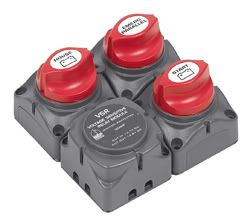Re: battery switch and charging
I always recommend to people when talking about dual battery setups to not try to charge 2 batteries at once with any outboard engine. You would be better off (as stated earlier) to charge your deep cycle with a shore charger once you get back from a day out.
Your outboard engine really isn't designed to recharge a dead battery as it doesn't have near the output of an automotive style alternator and it doesn't output at all during idle you've got to have the rpm's up before it even charges at all.... The easiest way to explain it is like this:
Say for example If you run a trolling motor, depth finder, bilge & lights and lets just say that that works out to 15 amps off of your battery per hour. A small outboard may have a 10 amp charging system (meaning it can put 10 amps back into a battery per hour) Thus it would take 1.5 hours at WOT to fully replace what you used. Charging systems on outboards vary a lot with 35 amp systems being available on newer, larger outboards so it is important to find out exactly what you are dealing with. Keep in mind if you happen to pick up a big group 27 battery with say 90 amp/hour reserve it would take even the 35 amp system about 2 1/2 hours at WOT to recharge it from a discharged state!!!
Thats burning alot of gasoline just to make your outboard charge up a battery... (which isn't at all what it's designed to do) The above setup was just strictly speaking of ONE battery if you had a starting battery + a deep cycle you would be looking at even longer to try to put charge back on the batteries.
The ALL setting in a 1-2-OFF-BOTH switch should really be reserved for Emergency use, being in the habit of switching to BOTH can very easily leave you with two dead batteries.
On normal use however your starting battery will be just fine cranking the boat then switching to battery #2 to keep it topped off or to run your loads (fish finder, radio, lights, trolling motor)






















